Last week, with the draw for bull moose in the glove box, my son Steve and I headed up the Thuya Creek drainage near Little Fort.
Each morning we travelled up the bony, rocky main road before daylight, in his F-150 Ford, to navigate the many logging roads and clear cuts.
Big bulls were tucked way in snowy, frozen, tall pine plantations and willow bogs, fattening up after the rut. (A bull moose will lose up to 150 pounds seeking out cows).
Over on the Darlington side of the mountain, his buddies had to deal with two grizzly bears, a cougar and lots of wolf activity, but no deer or moose.
It seems that the large predators, including clear-cut logging, are having a major effect on our efforts to put meat in the freezer.
Many years ago the Fish and Game branch had predator hunters who dealt with wild critters harassing ranchers’ livestock, or too many wolves taking down moose elk. (Leo Van Tine and Charlie Shuttleworth were two.)
Related: Return of the big bears
Methods used were cruel, with strychnine-laced chunks of horse meat dropped onto frozen lakes, come winter, to reduce wolf numbers.
Native bands in the north set out pieces of moose meat with small sinew cross-tied bone splinters to pierce the stomach, or a very sharp knife, embedded upright in the ice, with rabbit blood.
In today’s world of shrinking habitat, wolf, cougar, black bear and grizzly bears still must find prey, like moose, elk and caribou calves.
A large pack can travel many miles in a night, seeking out game. Too, research has found the larger the cut blocks in logging, wolves can take down prey like deer, moose and elk, as they cannot get away to find refuge.
For years now, ranchers in the Kootenays are losing calves to roving bands of wolves, and the Liberal government implemented a three-year culling program. Results are not in yet. One registered trapper is paid by the BC Cattlemen’s Association to take out wolves in the North Thompson/Adams plateau.
Twenty-eight was the number two seasons ago, but they only shipped three to the auction because the pelts were not prime due to warm weather.
It’s dammed if we do, dammed if we don’t try and control predators on a large scale, because they’re all part of the big picture in wildlife management and the realm of mother nature. Wolf populations, like rabbits and lynx, run in a seven-year cycle.
Man can’t wait for those cycles to evolve. The mournful howl of the wolf, when stilled, will mean other forms of wildlife, including our big-game animals will flourish, and once again roam without fear.!
Next week, some great game and fish recipes, including making hobo bread, for the hungry hunter in the bunch.
@SalmonArm
newsroom@saobserver.net
Like us on Facebook and follow us on Twitter
